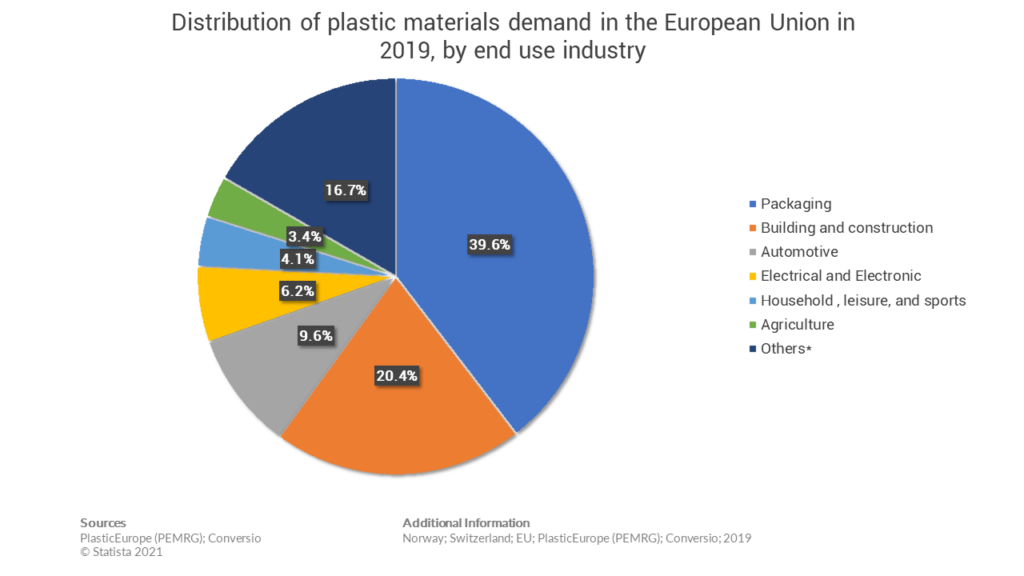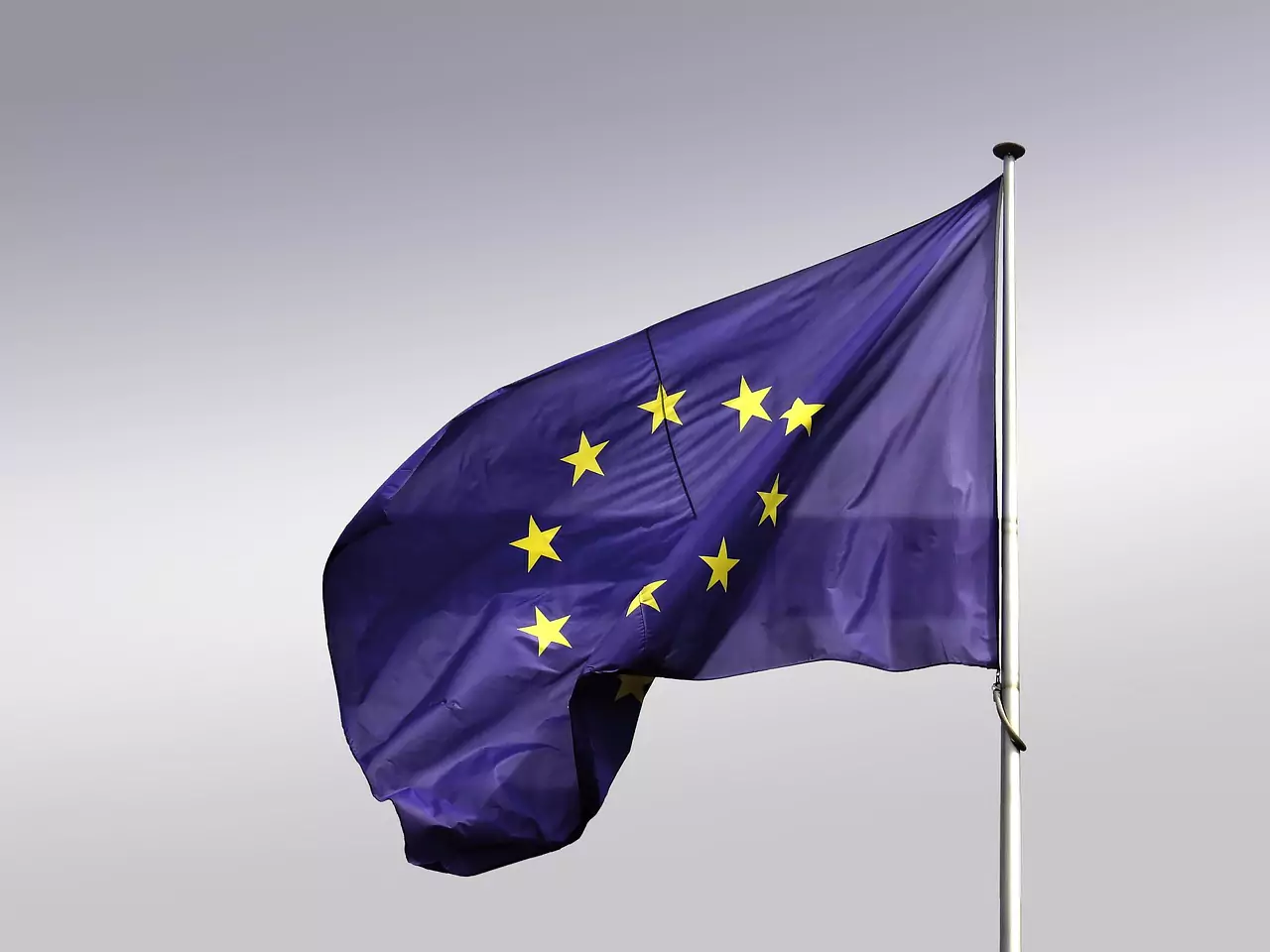The European plastics converter industry has recorded significant growth in recent years, with the packaging segment accounting for the largest share of demand. According to current data, the distribution of plastic materials market in the European Union by the end-use industry revealed that packaging accounted for 39% of total demand in 2019. This translates to an annual peak of 368 million metric tons and highlights a clear trend toward increased use of plastic in packaging. Other sectors are also important for plastic use, building and construction is second.
The continued growth in packaging is mainly due to its versatility and cost-effectiveness, making it a popular choice across various industries. It is crucial to protect and preserve products during transportation and storage, reduce food waste, and extend shelf life. Additionally, flexible packaging solutions continue to gain popularity as they offer convenience and ease of use for consumers while being more sustainable than traditional rigid packaging options. Plastic use by industries in the EU can be broken down further. The EU also provides some further date themselves here.
European Union Plastics Demand Reaches Unprecedented Levels in 2019
Here we will discuss the distribution of plastic materials demand in the European Union for various industries.

Packaging Industry
The European Union is one of the world’s largest consumers of plastic materials, with a constant demand for different applications. In 2019, the packaging segment accounted for the largest share of plastic materials demand in the European Union by usage, reaching 39.6%. This finding suggests that packaging remains one of the most significant end-use industries driving the growth and consumption of plastics in Europe. However, paper and cardboard is still the predominant packing material in the EU.
Building & Construction Industry
The building and construction segment accounted for a considerable share of demand in 2019. According to industry reports, this sector used approximately 20.4% of all plastic materials consumed within the EU that year. This highlights how essential plastics are in this particular industry and their contribution to the overall demand.
Automotive
The European Union’s automotive sector accounts for a substantial portion of this demand. In 2019, the usage of plastics in the automotive industry reached 9.6%. This represents a significant increase over previous years, reflecting the growing trend towards lightweight and fuel-efficient vehicles.
Electrical And Electronic
The European Union’s demand for plastic materials in 2019 was a little driven by the electrical and electronic production segment. Still, the industry uses plastic for various primary purposes, accounting for a significant market share. According to industry reports, this sector alone consumed over 6.2% of plastic materials across the continent. This underscores the growing importance of this industry in shaping the region’s economy and driving innovation.
Household, Leisure, And Sports
The household, leisure, and sports segment accounted for a share of this demand at 4.1%. This shows a growing need for plastics in these industries as consumers seek durable and lightweight products for their homes or leisure activities.
Agriculture
The agriculture industry has long been a significant consumer of plastic materials, and this trend is set to continue in the European Union. According to recent market research, the agriculture segment accounted for the share of plastic materials demand in the EU by usage at 3.4% in 2019. This indicates that farmers, agrochemical companies, and other stakeholders involved in agriculture rely heavily on plastic products.
Other Sectors
In 2019 some other sectors accounted for a considerable share of 16.7%. This category encompasses a diverse range of industries. The high demand for plastics in these sectors is due to their versatility and durability.
Reasons Behind The Growth of the European Plastic Industry
The European Union plastic industry has witnessed a significant boost in demand over recent years. One of the main reasons behind this growth is the increased production of biodegradable plastics. These eco-friendly plastics have become increasingly popular among consumers and businesses thanks to their ability to decompose naturally without harming the environment. This influences the clastic use by industries in the EU.
One another main reason behind this growth is the increased demand for reinforced plastics. Reinforced plastics are materials strengthened with fibers or other additives to enhance their mechanical properties.
Another factor driving the growth of the EU plastic industry is the increasing demand for lightweight and durable materials across various industries. This includes sectors such as automotive, aerospace, construction, and packaging. These industries require high-performance materials that withstand harsh environments and perform well under stress.
Another primary reason behind this surge is the widespread application of 3D printing (3DP) technology across various industries. With this cutting-edge technology, businesses can develop intricate designs and prototypes quickly and precisely, resulting in more efficient production processes.
Moreover, 3D printing reduces waste generation by enabling manufacturers to produce only what is needed. This capability has helped companies save costs associated with inventory management and reduce their carbon footprint. As a result, many industries are now using 3DP technology to manufacture items such as automotive parts, medical devices, consumer goods, and even aerospace components.
Wrapping Up
The plastic materials demand experienced a meteoric rise in the European Union in 2019, fueled by a booming end-use industry. Despite concerns over sustainability and environmental impact, the plastic industry shows no signs of slowing down. The EU is planning a plastic tax and circular use of these materials. Experts predict that the future is bright for this burgeoning sector.One of the main drivers of growth in the European Union’s plastic industry is its versatility. Plastic can be used in almost limitless applications across various sectors, from packaging and construction to automotive and electronics. As such, it has become an essential component for many European businesses. I hope you will enjoy this blog on plastic use by industries in the EU and quickly get crucial facts about the distribution of plastic in various sectors of the European Union plastic industry.




